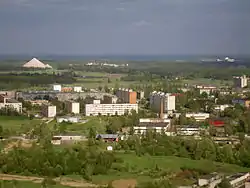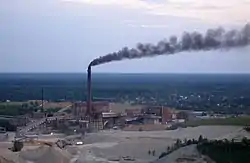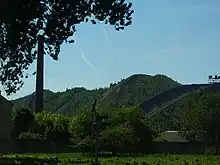Kiviõli | |
|---|---|
 | |
 Kiviõli Location in Estonia | |
| Coordinates: 59°21′N 26°58′E / 59.350°N 26.967°E | |
| Country | |
| County | |
| Municipality | |
| Founded | 1922 |
| Town rights | 1946 |
| Area | |
| • Total | 11.75 km2 (4.54 sq mi) |
| Population (2021)[1] | |
| • Total | 4,725 |
| • Rank | 23rd |
| • Density | 400/km2 (1,000/sq mi) |
| Ethnicity | |
| • Estonians | 39.6% |
| • Russians | 51.5% |
| • other | 8.9% |
| Time zone | UTC+2 (EET) |
| • Summer (DST) | UTC+3 (EEST) |
Kiviõli is an industrial town in Ida-Viru County, Estonia, established in 1922. The main industry in the town is oil shale mining, which gives the town its name (literally "stone oil").
Demographics
| Ethnicity | 1959[2] | 1970[3] | 1979[4] | 1989[4] | 2000[5] | 2011[6] | 2021[7] | |||||||
|---|---|---|---|---|---|---|---|---|---|---|---|---|---|---|
| amount | % | amount | % | amount | % | amount | % | amount | % | amount | % | amount | % | |
| Estonians | 6017 | 57.6 | 5789 | 51.9 | 4914 | 44.5 | 3958 | 38.1 | 2921 | 39.5 | 2179 | 38.7 | 1924 | 39.6 |
| Russians | - | - | 4431 | 39.7 | 5184 | 47.0 | 5369 | 51.7 | 3793 | 51.2 | 3020 | 53.6 | 2498 | 51.5 |
| Ukrainians | - | - | 152 | 1.36 | 228 | 2.06 | 308 | 2.96 | 157 | 2.12 | 109 | 1.93 | 136 | 2.80 |
| Belarusians | - | - | 93 | 0.83 | 139 | 1.26 | 184 | 1.77 | 119 | 1.61 | 79 | 1.40 | 69 | 1.42 |
| Finns | - | - | 368 | 3.30 | 348 | 3.15 | 308 | 2.96 | 193 | 2.61 | 100 | 1.77 | 68 | 1.40 |
| Jews | - | - | 13 | 0.12 | 11 | 0.10 | 10 | 0.10 | 3 | 0.04 | 2 | 0.04 | 0 | 0.00 |
| Latvians | - | - | 41 | 0.37 | 25 | 0.23 | 19 | 0.18 | 10 | 0.14 | 10 | 0.18 | 10 | 0.21 |
| Germans | - | - | - | - | 74 | 0.67 | 83 | 0.80 | 46 | 0.62 | 49 | 0.87 | 31 | 0.64 |
| Tatars | - | - | - | - | 13 | 0.12 | 26 | 0.25 | 14 | 0.19 | 7 | 0.12 | 6 | 0.12 |
| Poles | - | - | - | - | 26 | 0.24 | 22 | 0.21 | 11 | 0.15 | 7 | 0.12 | 7 | 0.14 |
| Lithuanians | - | - | 18 | 0.16 | 27 | 0.24 | 24 | 0.25 | 17 | 0.23 | 14 | 0.25 | 12 | 0.25 |
| unknown | 0 | 0.00 | 0 | 0.00 | 0 | 0.00 | 0 | 0.00 | 70 | 0.94 | 4 | 0.07 | 5 | 0.10 |
| other | 4427 | 42.4 | 248 | 2.22 | 61 | 0.55 | 79 | 0.76 | 51 | 0.69 | 54 | 0.96 | 86 | 1.77 |
| Total | 10444 | 100 | 11153 | 100 | 11050 | 100 | 10390 | 100 | 7405 | 100 | 5634 | 100 | 4854 | 99.9 |
Neighborhoods of Kiviõli
Included in the town limits, but somewhat separate from the main part of the town, are the districts of Küttejõu and Varinurme.
There are five neighborhoods of Kiviõli:
- Küttejõu
- Lepatee
- Sala-Aru
- Soopealse
- Varinurme.[8]
Gallery
 Kiviõli oil factory
Kiviõli oil factory.JPG.webp)

 Ash mountains
Ash mountains
See also
References
- ↑ "Population by sex, age group and place of residence after the 2017 administrative reform, 1 January". Statistics Estonia. Retrieved 26 December 2021.
- ↑ Katus, Kalev; Puur, Allan; Põldma, Asta (2002). Rahvastiku ühtlusarvutatud sündmus- ja loendusstatistika: Ida-Virumaa 1965-1990. Sari C (in Estonian and English). Tallinn: Eesti Kõrgkoolidevaheline Demouuringute Keskus. pp. 31–32. ISBN 9985-820-66-5.
- ↑ Население районов, городов и поселков городского типа Эстонской ССР : по данным Всесоюзной переписи населения на 15 января 1970 года. Таллинн, 1972.
- 1 2 Eesti Vabariigi maakondade, linnade ja alevite rahvastik: 1989. a. rahvaloenduse andmed: statistikakogumik. 1. osa: Rahvaarv rahvuse, perekonnaseisu, hariduse ja elatusallikate järgi. Tallinn: Statistikaamet. 1990. pp. 28, 33. ISBN 978-9949-71-932-7.
- ↑ "RL222: RAHVASTIK ELUKOHA JA RAHVUSE JÄRGI". Estonian Statistical Database (in Estonian).
- ↑ "RL0429: RAHVASTIK RAHVUSE, SOO, VANUSERÜHMA JA ELUKOHA JÄRGI, 31. DETSEMBER 2011". Estonian Statistical Database (in Estonian).
- ↑ "RL21429: RAHVASTIK RAHVUSE, SOO, VANUSERÜHMA JA ELUKOHA (HALDUSÜKSUS) JÄRGI, 31. DETSEMBER 2021". Estonian Statistical Database (in Estonian).
- ↑ "LINNAOSADE JA -JAGUDE LÜHENDID". eki.ee (in Estonian). Retrieved 18 March 2020.
External links
Wikimedia Commons has media related to Kiviõli.
59°21′N 26°58′E / 59.350°N 26.967°E
This article is issued from Wikipedia. The text is licensed under Creative Commons - Attribution - Sharealike. Additional terms may apply for the media files.
